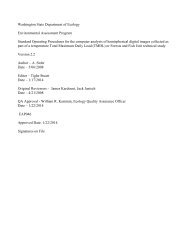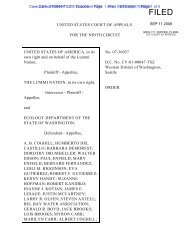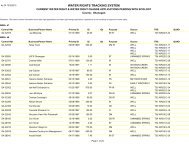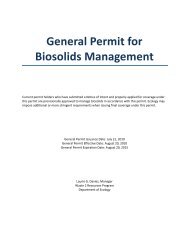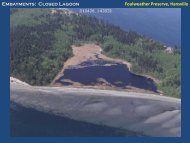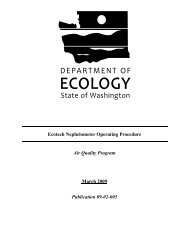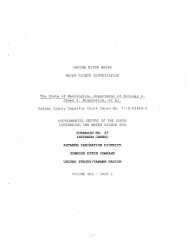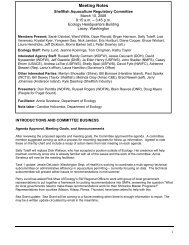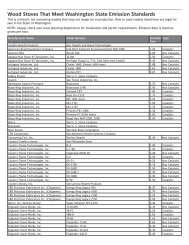WRIA 62 WMP 032305 - Washington State Department of Ecology
WRIA 62 WMP 032305 - Washington State Department of Ecology
WRIA 62 WMP 032305 - Washington State Department of Ecology
Create successful ePaper yourself
Turn your PDF publications into a flip-book with our unique Google optimized e-Paper software.
March, 2005 -43- 023-1289-003.3040<br />
those situations where it is clear that overriding considerations <strong>of</strong> the public interest will be<br />
served.<br />
Since the <strong>WRIA</strong> <strong>62</strong> Watershed Planning Unit opted not to address instream flows within Phase II <strong>of</strong><br />
Watershed Planning, the law states that <strong>Ecology</strong> will perform this task at some time in the future. At<br />
present, <strong>Ecology</strong> has no specific timeframe nor locations for conducting instream flow studies in <strong>WRIA</strong><br />
<strong>62</strong> but acknowledges that the studies will occur sometime in the future.<br />
Since instream flow needs are a component <strong>of</strong> the equation to quantify water availability in a watershed<br />
or sub-basin, the <strong>WRIA</strong> <strong>62</strong> Watershed Planning Unit believes that it is important for the <strong>WRIA</strong> <strong>62</strong> Phase<br />
IV Implementing Body to be involved in instream flow setting in <strong>WRIA</strong> <strong>62</strong>. The <strong>WRIA</strong> <strong>62</strong> Watershed<br />
Planning Unit believes that it would be most useful for instream flows to be developed as a priority in the<br />
southern sub-basins <strong>of</strong> Calispell, Davis, Skookum, Kent and McCloud that are expected to experience<br />
the highest population growth rates and therefore water demand in the future. However, the Watershed<br />
Planning Unit also acknowledges that instream flows may need to be developed for all major tributaries<br />
in <strong>WRIA</strong> <strong>62</strong>. Furthermore, the Watershed Planning Unit insists that any setting <strong>of</strong> minimum instream<br />
flows be based on the best available science and methodologies to support the establishment <strong>of</strong> the<br />
minimum instream flows.<br />
At the November 2004 Watershed Planning Unit meeting, the Watershed Planning Unit agreed by<br />
consensus to recommend instream flow setting in <strong>WRIA</strong> <strong>62</strong> during Phase IV <strong>of</strong> Watershed Planning in<br />
the collaborative manner described in RCW 90.82.080 (Appendix C1). This proposal was presented to<br />
the Pend Oreille County Commissioners on December 13, 2004 for their approval. At this meeting the<br />
Commissioners (Mitch Brown, Mike Hanson and Sam Nicholas) approved the Planning Unit’s<br />
recommendation to address instream flows within the southern sub-basins that are expected to experience<br />
the greatest population growth.<br />
In terms <strong>of</strong> rule-making, <strong>Ecology</strong> agreed that instream flow studies for as many remaining tributaries<br />
in <strong>WRIA</strong> <strong>62</strong> as feasible should be completed prior to entering into rule-making. <strong>Ecology</strong> and WDFW<br />
agreed, at least preliminarily, that further Pend Oreille River mainstem flow analysis may not be<br />
warranted and that <strong>Ecology</strong> and WDFW could support a flow <strong>of</strong> 7,700 cfs at Newport in regulation<br />
(email communication between Hal Beecher (WDFW) and Mimi Wainwright (<strong>Ecology</strong>), October 27,<br />
2004). Instream flow studies for tributaries in <strong>WRIA</strong> <strong>62</strong> might be completed a number <strong>of</strong> ways: some<br />
may already have acceptable recommended flows; some may be completed by the Pend Oreille<br />
Native Salmonid Recovery Team; the Watershed Planning Implementing Body may choose to<br />
conduct some instream flow studies; and/or remaining flows could be completed with<br />
WDFW/<strong>Ecology</strong> resources.<br />
The Watershed Planning Unit noted that the minimum discharge mandated by Congress for Albeni<br />
Falls Dam is 4,000 cfs. With the intent <strong>of</strong> making this minimum discharge consistent with the future<br />
minimum instream flow rule for the Pend Oreille River, the Planning Unit recommends that <strong>Ecology</strong><br />
consider petitioning the <strong>Washington</strong> <strong>State</strong> Governor to write a letter to Congress to raise the<br />
minimum discharge from Albeni Falls Dam from 4,000 cfs to be equivalent to the minimum instream<br />
flow rule (after this rule is established).<br />
Water rights issued by <strong>Ecology</strong> from the main stem <strong>of</strong> the Pend Oreille River for the last couple <strong>of</strong><br />
years have been conditioned to the 7,700 cfs at the Newport gage. 7,700 cfs is a minimum flow for<br />
regulation (i.e. it is a SWSL and not a minimum instream flow rule). Based on the historic record, the<br />
flows in the Pend Oreille River fall below 7,700 cfs at the Newport gage one year in ten, usually in<br />
August. When <strong>Ecology</strong> goes into rule making to set minimum instream flows in <strong>WRIA</strong> <strong>62</strong>, it is<br />
<strong>WRIA</strong> <strong>62</strong> <strong>WMP</strong> <strong>032305</strong>



